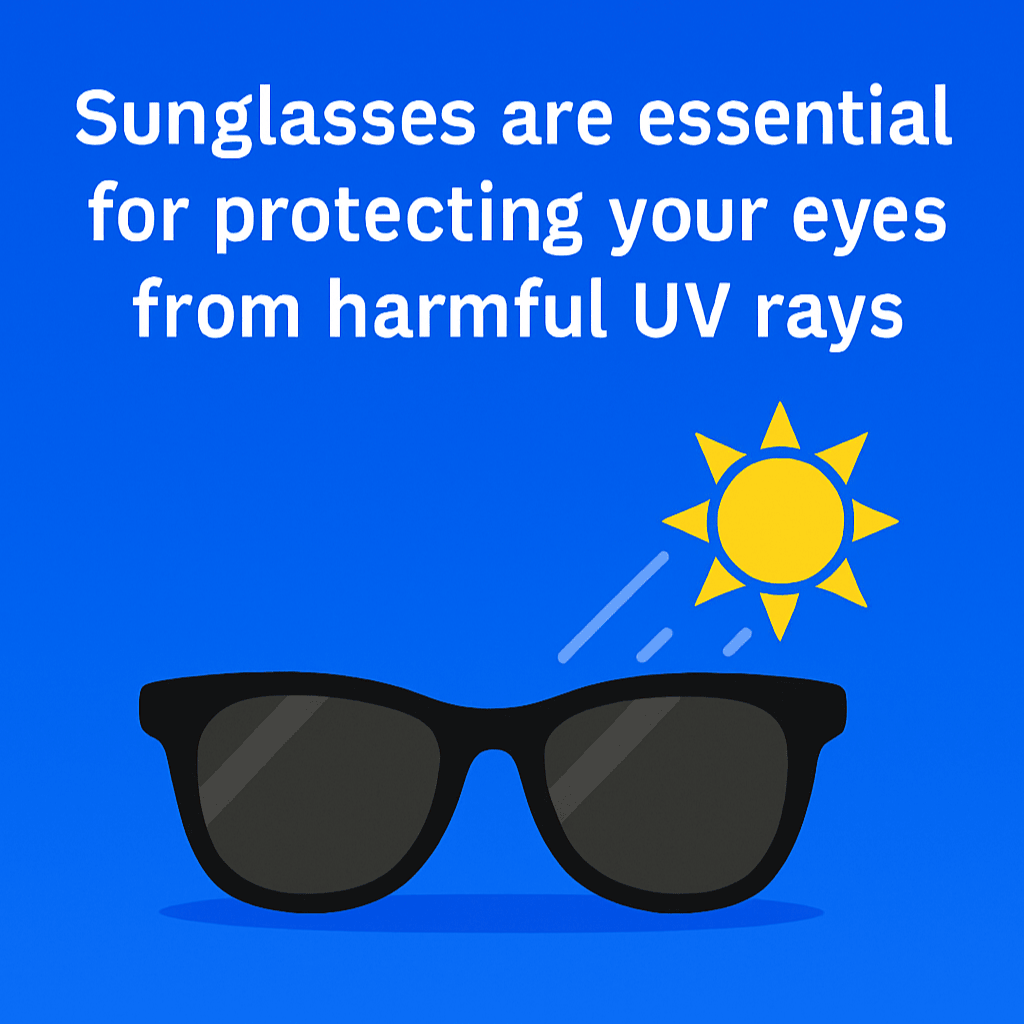Choosing the right pair of sunglasses is more than just about style; it’s a crucial decision that directly affects the health and protection of your eyes. With numerous options available in the market, it can feel overwhelming to pick the right one. This guide will break down the key elements you need to consider when making your purchase. From choosing the ideal frame to understanding lens types and UV protection, we’ll cover everything you need to know to make an informed decision for 2025.

1. Why Is Choosing the Right Pair of Sunglasses Important?
Sunglasses are more than just a fashion accessory. They are essential tools for protecting your eyes from the harmful effects of UV rays. But here’s the kicker—sunglasses that don’t provide proper protection can lead to long-term damage such as cataracts, macular degeneration, and even skin cancer around your eyes. So, what’s the real story? Choosing the right pair goes beyond aesthetics; it directly impacts your eye health and comfort.
The first thing to consider is the protection sunglasses provide. Proper UV protection is a must. Overexposure to UV rays can lead to eye damage. For example, prolonged exposure can increase the risk of cataracts by 20%, making UV protection non-negotiable. In addition to blocking UV rays, sunglasses shield your eyes from glare, which can be incredibly harmful, especially while driving or outdoors.
Choosing sunglasses with high-quality UV protection ensures long-term eye health and comfort, offering better clarity in bright conditions. This means fewer headaches and eye strain. While style matters, protecting your vision should always come first.
| UV Protection Level | Percentage Blocked | Best For |
|---|---|---|
| 100% UV | 99%-100% | Everyday wear |
| 90%-99% | 90%-99% | Sports, driving |
| Below 90% | Below 90% | Indoor/outdoor fashion |
2. How Do I Know Which Sunglasses Suit My Face Shape?
This is where it gets interesting—choosing sunglasses that suit your face shape is as important as UV protection. Sunglasses that match your face shape enhance both comfort and style. But how do you know which styles work for you? The right sunglasses can accentuate your features, making your face look more balanced and proportionate.
The first step is to identify your face shape. Are you oval, square, round, or heart-shaped? Once you know your shape, it’s easier to pick frames that complement it. For example, round faces tend to look best with angular or rectangular frames, which help define the face. On the other hand, square faces benefit from softer, round frames that soften the edges of the jawline.
If you have a heart-shaped face, wider frames or aviators work best, balancing your features. For oval faces, almost any style works, but rectangular or square frames help add definition. In addition to complementing your face shape, consider the color of your frames. Lighter frames suit fair skin tones, while darker frames work well for darker complexions.
| Face Shape | Best Frame Shape | Example |
|---|---|---|
| Round | Square, rectangular | Classic wayfarer |
| Square | Round, oval | Aviator sunglasses |
| Oval | Square, angular | Bold square frames |
| Heart-shaped | Oval, cat-eye | Cat-eye sunglasses |
3. What Are the Different Types of Sunglass Lenses?
You might be wondering, what’s the real difference between lens types, and why does it matter? Let’s break it down. Lens technology has come a long way, offering various options that go beyond basic color tinting. Polarized lenses, for instance, are a must for reducing glare. These lenses are perfect for anyone who spends a lot of time on the water or driving.
On the other hand, mirrored lenses reflect light away from your eyes, reducing the amount of light that enters the lens. Gradient lenses, which are dark at the top and lighter at the bottom, are ideal for driving, as they shield your eyes from overhead sunlight while maintaining clear vision below.
Another popular option is photochromic lenses, which adjust to light levels automatically. These lenses turn darker in bright light and clear up indoors. This technology is especially useful for people who frequently move between different environments, providing a seamless transition without the need for multiple pairs of glasses.
| Lens Type | Benefits | Best For |
|---|---|---|
| Polarized | Reduces glare | Water activities, driving |
| Mirrored | Reflects light | Bright environments |
| Gradient | Light-to-dark transition | Driving, outdoor activities |
| Photochromic | Adjusts to light | Indoors and outdoors |
4. How Does the Material of Sunglasses Affect Quality?
When it comes to sunglasses, the material used for both the lenses and frames plays a significant role in determining quality, durability, and comfort. Let’s look at the materials used and how they impact your sunglasses experience. The kicker here is that what you choose could determine how long your sunglasses last and how comfortable they are throughout the day.
Acetate is one of the most common materials for frames. It’s lightweight, durable, and can be molded into various shapes and colors. For people seeking sturdy, flexible frames, acetate offers excellent longevity and style versatility. Metal frames, particularly titanium, are lighter and offer a more refined aesthetic. Titanium frames are incredibly durable, hypoallergenic, and resistant to corrosion, making them an excellent choice for those looking for high-quality sunglasses.
Plastic frames, while lightweight and affordable, may not be as durable as acetate or metal options. However, they come in a range of vibrant colors and styles, making them a great choice for casual wear. When it comes to lenses, polycarbonate lenses are a popular choice for their lightweight and shatter-resistant properties, making them perfect for sports and outdoor activities.
| Frame Material | Durability | Comfort Level |
|---|---|---|
| Acetate | High | Lightweight |
| Metal (Titanium) | High | Durable, refined look |
| Plastic | Moderate | Light, vibrant styles |
5. What Lens Features Should I Consider for Optimal Protection?
When you choose sunglasses, protection should be your primary concern. So, what’s the real deal? Are you fully covered from the sun’s harmful rays? UV protection is the most important lens feature to look for. But that’s not all. Sunglasses with an anti-glare coating provide better visual clarity by reducing the amount of light bouncing off reflective surfaces.
Anti-scratch coatings are another must-have, especially for those who wear their sunglasses daily. Scratches can quickly degrade the quality of lenses, leading to reduced visibility and comfort. Another feature that has gained popularity is blue light filtering. Sunglasses equipped with blue light filtering lenses reduce the amount of blue light that enters your eyes, which can help prevent digital eye strain caused by long hours of screen exposure.
With all these features, you’re not only protecting your eyes from harmful UV rays but also enhancing your comfort and visual clarity. Here’s the kicker—choosing sunglasses with the right features helps you protect your eyes while boosting your style.
| Lens Feature | Benefit | Ideal For |
|---|---|---|
| UV Protection | Shields eyes from UV rays | Everyday use, outdoor activities |
| Anti-glare Coating | Reduces glare | Driving, sports |
| Anti-scratch Coating | Protects from damage | Daily wear |
| Blue light Filtering | Reduces digital eye strain | Screen users |
6. What is the Best Color for Sunglass Lenses?
When it comes to selecting the best lens color, it’s not just about aesthetics. You might be surprised to know that different lens colors serve various practical purposes. For example, gray lenses reduce overall brightness while preserving natural color balance. This makes them ideal for outdoor activities like hiking or driving.
Brown lenses, on the other hand, enhance contrast and depth perception, making them great for sports or conditions where you need better visibility in bright or variable light. Yellow or gold lenses enhance contrast in low-light conditions, making them perfect for cloudy days or early morning activities.
The color of your lenses can also influence the way you see the world. Choose wisely, as the right lens color can make a significant difference in comfort and performance.
| Lens Color | Benefits | Best For |
|---|---|---|
| Gray | Reduces brightness, maintains color | Outdoor activities |
| Brown | Enhances contrast, depth perception | Sports, driving |
| Yellow/Gold | Improves contrast in low light | Cloudy days, early mornings |
7. Should I Choose Sunglasses for Fashion or Function?
What’s the real story? Should you choose sunglasses based on fashion, function, or a mix of both? While sunglasses are undoubtedly a statement accessory, their primary function should be to protect your eyes from harmful UV rays. That being said, there’s no reason you can’t have both style and functionality.
Many popular brands offer sunglasses that combine the best of both worlds, offering high-quality UV protection while also keeping up with the latest fashion trends. In 2025, aviators, oversized frames, and colorful lenses are expected to dominate the market. However, it’s important not to overlook the technical features that can improve comfort and safety. Polarized lenses, for instance, combine both form and function by offering enhanced protection against glare.
| Sunglasses Style | Function | Fashion Trend |
|---|---|---|
| Aviators | UV protection, glare reduction | Timeless |
| Oversized | Sun coverage | Bold, modern look |
| Colorful Lenses | UV protection, style | Trendy, youthful |
8. How Do I Ensure Sunglasses Are Comfortable?
When choosing sunglasses, comfort should never be overlooked. If your sunglasses aren’t comfortable, you’re less likely to wear them, and the purpose of protection and style will be lost. Here’s the deal: comfort is all about the fit. Sunglasses that pinch your nose or squeeze your temples can quickly become a nuisance.
The best way to ensure comfort is to look for adjustable nose pads. These pads help distribute the pressure evenly and can be customized to fit the shape of your nose. Another key factor is the temple length. Sunglasses with temples that are too short or long can cause discomfort behind your ears. Always check that the frame fits well and feels secure without being tight.
| Frame Fit | Feature | Benefit |
|---|---|---|
| Adjustable Nose Pads | Custom fit | Prevents discomfort |
| Temple Length | Proper adjustment | Ensures a snug fit |
9. What is the Difference Between Men’s and Women’s Sunglasses?
Sunglasses come in different shapes and sizes, and this extends to gender-specific options as well. Men’s sunglasses tend to have wider frames and bolder designs, while women’s sunglasses are often smaller and more delicately styled. However, the main difference is not only in size and aesthetics but also in functionality.
Men typically look for sunglasses that offer more robust designs and durability, while women might focus more on fashion-forward choices that enhance their appearance. Unisex sunglasses, however, have become more popular and can provide the best of both worlds by offering both style and functionality suitable for any wearer.
| Gender | Frame Style | Common Features |
|---|---|---|
| Men | Bold, wide | Durable, larger frames |
| Women | Sleek, smaller | Fashion-forward designs |
10. How Can I Maintain My Sunglasses to Ensure Longevity?
Proper care and maintenance are essential for ensuring your sunglasses last for years. Here’s the kicker—sunglasses are often subjected to the elements, and neglecting proper care can lead to damage. First, always store your sunglasses in a case when not in use. This prevents scratches and keeps them from getting crushed.
Regular cleaning is another essential step. Use a microfiber cloth and lens cleaning solution to wipe away dust and fingerprints. Avoid using clothing or paper towels, as these materials can scratch the lenses. Also, don’t forget to regularly check for loose screws or damaged parts.
| Maintenance Tip | Action | Benefit |
|---|---|---|
| Store in Case | Keep lenses protected | Prevents scratches |
| Clean Regularly | Use microfiber cloth | Keeps lenses clear and scratch-free |
11. What Are the Best Brands for Sunglasses in 2025?
When it comes to investing in quality sunglasses, the brand matters. In 2025, several well-known brands are expected to lead the market. Brands like Ray-Ban, Oakley, and Persol continue to dominate with their high-quality frames and lenses. However, newer brands are making waves, offering innovative designs and premium materials.
Ray-Ban is known for its classic styles, like the aviator and wayfarer, which have stood the test of time. Oakley, on the other hand, is favored by athletes for its sport-oriented designs and polarized lenses. Persol offers luxury options with unique styling and high-end materials.
| Brand | Style | Best For |
|---|---|---|
| Ray-Ban | Classic | Everyday wear |
| Oakley | Sporty | Athletes, outdoor activities |
| Persol | Luxury | Fashion-forward wearers |
12. How Do I Choose Sunglasses for Specific Activities?
What’s the real story when it comes to selecting sunglasses for specific activities? Not all sunglasses are suitable for every occasion. For example, if you’re looking for sunglasses for driving, polarized lenses are a must, as they reduce glare from reflective surfaces. If you’re into sports, you’ll need lightweight, durable frames that stay in place.
Sports sunglasses are designed with materials like rubberized temples to prevent slipping and frames that stay secure during intense activities. For outdoor adventures, opt for sunglasses that provide full UV protection, as well as comfort for long durations. In 2025, innovation is pushing the envelope, with more brands incorporating interchangeable lenses and customizable fits for different activities.
| Activity | Lens Type | Features |
|---|---|---|
| Driving | Polarized | Reduces glare |
| Sports | Durable | Non-slip, impact-resistant |
| Outdoor | UV protection | Long-lasting comfort |
13. What Is the Average Price of High-Quality Sunglasses?
When it comes to pricing, the range of sunglasses is vast. Budget sunglasses can cost as little as $20, but high-quality sunglasses typically start around $100. High-end brands can cost several hundred dollars, but do you really need to spend that much? Here’s the real story—premium sunglasses often come with better materials, more advanced lens technology, and greater durability.
The key is knowing when it’s worth investing in a pair of expensive sunglasses and when a budget pair will do. If you need sunglasses for occasional wear, a less expensive pair might suffice. However, if you plan to wear them daily and want something that will last, investing in higher-end sunglasses could save you money in the long run.
| Price Range | Features | Best For |
|---|---|---|
| $20-$50 | Basic UV protection | Occasional wear |
| $100+ | Advanced features, durability | Daily use |
14. Where Should I Buy Sunglasses?
When it comes to buying sunglasses, knowing where to shop is key. Online stores like Amazon, Warby Parker, and Sunglass Hut offer a wide selection, but buying in-store gives you the chance to try on sunglasses and check the fit. For high-end brands, it’s often better to shop at an authorized dealer or brand-specific store to ensure authenticity.
Shopping from a reputable store ensures you’re getting a genuine product with a warranty and return options. Also, consider checking the return policy before purchasing, especially when buying sunglasses online, as trying on glasses in-store offers an added benefit of assessing fit before committing.
| Store Type | Advantages | Disadvantages |
|---|---|---|
| Online | Convenience, variety | Can’t try on glasses |
| In-store | Try before you buy | Limited selection |
15. Conclusion
Choosing the right sunglasses involves balancing several factors such as fit, style, UV protection, and functionality. When selecting sunglasses for 2025, keep in mind that the best pair is not just about looks but also about protecting your eyes. Ensure they fit well, provide adequate protection, and are suited for your daily activities.
The decision might seem daunting, but armed with the right knowledge, you can easily choose a pair of sunglasses that meet your needs while looking great. Remember to choose sunglasses that suit your face shape, offer the best lens protection, and provide lasting comfort.
FAQ Section
Q1: What is the most important factor when choosing sunglasses?
The most important factor is ensuring that the sunglasses provide adequate UV protection to safeguard your eyes from harmful rays.
Q2: How does polarized lens technology work?
Polarized lenses reduce glare from reflective surfaces like water, snow, or roads, improving visual clarity and reducing eye strain.
Q3: What type of sunglasses are best for driving?
For driving, sunglasses with polarized lenses are ideal as they cut down glare, especially from wet or reflective surfaces.
Q4: Are expensive sunglasses really worth the price?
Expensive sunglasses often offer superior durability, better UV protection, and more comfortable fits, making them a good investment for long-term use.
Q5: How can I tell if my sunglasses are properly fitted?
Your sunglasses should sit comfortably on your nose and ears without sliding off, while also covering your eyes completely without causing discomfort.

